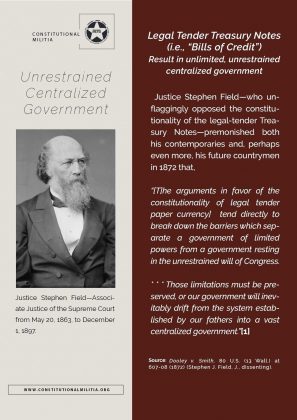Last Updated on July 11, 2022 by Constitutional Militia
Learn about and download the Electronic Gold Currency Plan(Gold Money Bill) here.
The State of Montana has proposed Alternative Currency in House Bill 639. Learn more here.
To learn about the “Money” power of the States: An Introductory Primer on the Constitutional Authority of the States to Adopt an Alternative Currency here.
CONGRESS EMPOWERED AND DISABLED FROM USING SILVER AND GOLD ONLY AS “MONEY” IN ALL GOVERNMENTAL FISCAL TRANSACTIONS
“Power of the Purse”: Entrusted to Congress
The Constitution delegates the “Power of the Purse” to Congress. That is the governmental power “To lay and collect Taxes,..”, and to spend those monies “for the common Defense and general Welfare of the United States…”.[1] Congress also has the power “To…borrow Money…”.[2] The Constitution then specifies and thereby imposes a disability on the form of “Money” the States must use as a Tender when performing their constitutional duties—“gold and silver” in the form of “Coin”. [3]
One particularly clear provision in the Constitution is the duty “No State shall make any Thing but gold and silver Coin a Tender in Payment of Debts…”.[4] That duty was reinforced with the disability “No State shall…emit Bills of Credit”.[5] A “bill of credit” was a term of art for “paper money”. This provision makes pellucid that all “paper money” is unconstitutional whether redeemable in some other commodity or not. Under the Articles of Confederation, each State had the power to “emit bills”.[6] And the States did emit bills with disastrous results—hyperinflation and economic devastation. When the Articles of Confederation were replaced with a Constitution, the power to “emit bills” was carried over into the original draft of the Constitution. This power was debated and voted down 9-2, and that power was removed.[7] This was a rare, and possibly the only, instance in history when such a huge political blunder was made and the men who made that blunder acknowledged it as such and actually corrected it.
Unfortunately, this was not the end of the paper money schemes that would plague Americans. Immediately upon ratification of the Constitution the banks set out to infiltrate Congress[8] in order to emit bills of credit (paper money). Then in the late 1800s with a Civil War looming, Abraham Lincoln would violate the Constitution by emitting bills of credit (paper money) that came to be known as the “Lincoln Greenback”. This paved the way for serial blunders and plunders by Congress and the special interests who work their strings, consecrated by inept, incompetent, and bungling Supreme Court decisions. Until we arrive at the Federal Reserve System we have today which was established in 1913 for the purpose of “emit[ting] Bills of Credit”. Federal Reserve Notes, which are bills of credit—continue to circulate to this day—debt masquerading as currency—syphoning the wealth from average American’s pocket because the average American does not know the legal definition of a constitutional “dollar” or why it is vital to his economic security.
As early as 1830, the observation was made by Justice J. Johnson, “[t]he terms , ‘bills of credit,’ are themselves vague and general, and, at the present day, almost dismissed from our language. It is then only by resorting to the nomenclature of the day of the Constitution, that we can hope to get at the idea which the framers *** attached to it.”[9]
The engine of arbitrary governmental power is paper money. Expansion of those powers requires an expansion of the currency—one cannot exist without the other. States can reinstitute constitutional “Money”—silver and gold—and walk away from a collapsing Federal Reserve System, no consent from Congress necessary.































